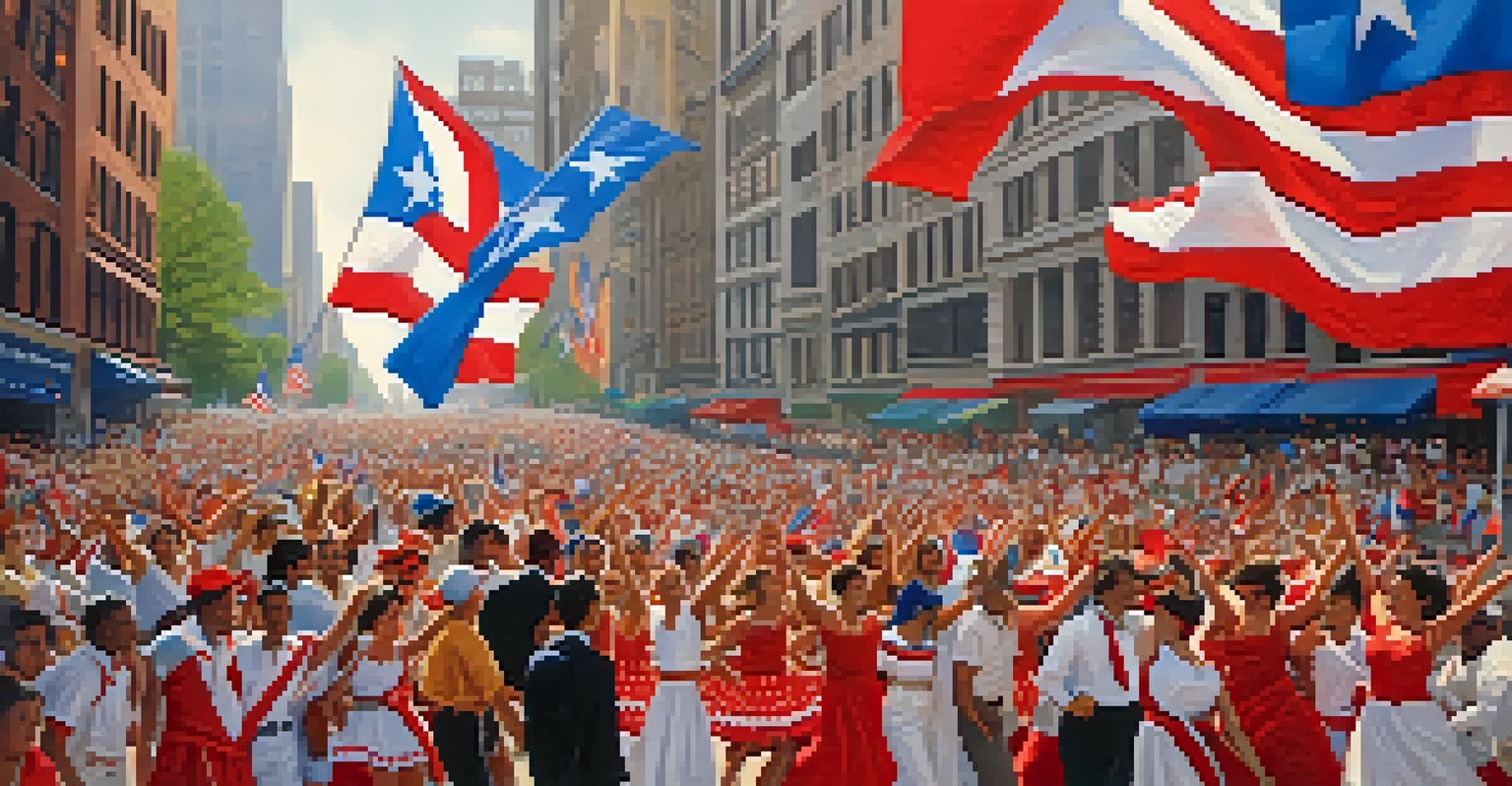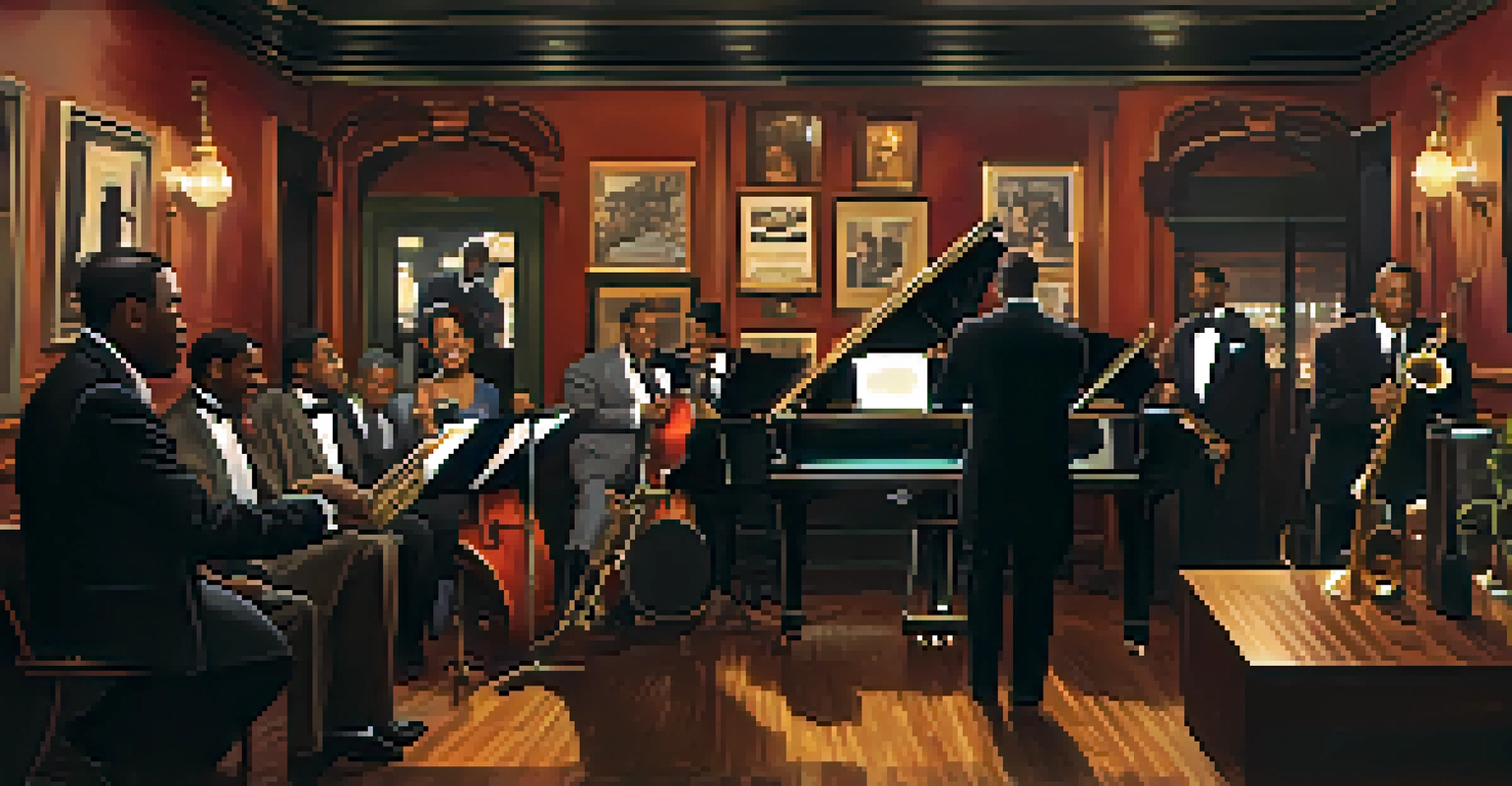Ethnic Contributions: New York's Rich Cultural Heritage

The Melting Pot: A Brief Overview of New York's Diversity
New York City is often referred to as a melting pot, and for good reason. With over 800 languages spoken, the city's rich tapestry of cultures contributes to its unique identity. From bustling neighborhoods to iconic festivals, the influence of various ethnic groups is palpable in everyday life.
New York is not a city; it's a world.
This diversity is not just a statistic; it’s the heart of the city's character. Whether walking through Chinatown or Little Italy, you can feel the history and traditions that each community brings. These neighborhoods serve as microcosms of their respective cultures, offering authentic food, music, and art.
As we delve deeper into the cultural contributions of different ethnic groups, it becomes clear that New York's identity is continuously evolving. Each wave of immigration has added layers to this vibrant city, making it a fascinating lens through which to explore cultural heritage.
Italian American Influence: From Cuisine to Culture
Italian Americans have played a significant role in shaping New York's cultural landscape, particularly through their cuisine. Dishes like pizza and pasta have become staples not just in the city, but across the nation. These culinary delights tell a story of tradition, family, and community that resonates with many.

Beyond food, Italian Americans have made substantial contributions to the arts, particularly in theater and music. Iconic figures like Frank Sinatra and Tony Bennett have roots in the Italian American community, bringing their unique flair to the world stage. Their influence continues to inspire new generations of artists.
New York's Cultural Diversity
New York City is a vibrant melting pot, with over 800 languages spoken and diverse communities contributing to its unique identity.
As we celebrate Italian American heritage, we see a blend of old-world traditions and modern interpretations. Festivals like the Feast of San Gennaro in Little Italy highlight this vibrant culture, showcasing the importance of community and the joy of sharing cultural experiences.
Jewish Contributions: Resilience and Innovation
The Jewish community in New York has a profound history marked by resilience and innovation. Arriving in waves, particularly during the late 19th and early 20th centuries, Jewish immigrants brought with them rich traditions and a strong work ethic. This community has significantly shaped New York’s economy, arts, and social fabric.
The beauty of New York is that it is a city of immigrants, and the strength of our city is found in that diversity.
Culturally, Jewish New Yorkers have left an indelible mark on Broadway, literature, and film. From the comedic genius of Mel Brooks to the profound storytelling of writers like Philip Roth, their contributions have enriched American culture as a whole. The celebration of Jewish holidays and traditions also adds to the city’s colorful tapestry.
Places like the Lower East Side Tenement Museum tell the story of Jewish immigrants and their journey, reminding us of the challenges they faced. This legacy of perseverance and creativity is a cornerstone of New York's identity, demonstrating how diverse experiences can create a richer cultural narrative.
Hispanic and Latino Heritage: A Celebration of Culture
Hispanic and Latino communities have become a vibrant force in New York City, contributing to its cultural richness in countless ways. From the lively streets of El Barrio to the colorful murals of Bushwick, their influence is seen and felt everywhere. Celebrations like the Puerto Rican Day Parade showcase this heritage, bringing together people to honor their culture.
Music and dance, such as salsa and merengue, have roots deeply embedded in these communities. New York is known as the birthplace of many Latin music genres, and venues across the city regularly feature lively performances that keep these traditions alive. The sound of drums and the rhythm of dance create an atmosphere of joy and unity.
Significant Ethnic Contributions
Various ethnic groups, including Italian Americans, Jewish, Hispanic, Asian, Caribbean, and African Americans, have deeply influenced the city's culture through food, music, and traditions.
Furthermore, Hispanic and Latino contributions extend to cuisine, with delicious offerings like tacos, empanadas, and arepas becoming mainstream favorites. This fusion of flavors not only satisfies the palate but also tells a story of cultural exchange and connection, enriching New York's culinary landscape.
The Asian American Experience: A Cultural Mosaic
Asian Americans have significantly shaped New York's identity, contributing a diverse range of traditions, languages, and culinary delights. Communities such as Chinatown and Koreatown are vibrant hubs that showcase this rich heritage. The annual Lunar New Year celebrations in these neighborhoods attract thousands, highlighting the importance of cultural preservation.
Beyond food and festivals, Asian Americans have made notable strides in various fields, including technology, arts, and activism. Figures like filmmaker Ang Lee and chef David Chang exemplify the impact of Asian creativity and innovation in the broader cultural landscape. Their achievements inspire future generations to embrace their heritage.
The Asian American experience in New York is one of resilience and adaptation, with each wave of immigrants adding to the cultural mosaic. This ongoing evolution reflects the city's spirit of inclusivity, where diverse backgrounds come together to create a dynamic and vibrant community.
Caribbean Influence: Rhythm and Flavor in NYC
The Caribbean community has profoundly influenced New York's cultural scene, bringing a unique blend of rhythms, flavors, and traditions. Events like the West Indian American Day Carnival in Brooklyn attract large crowds, celebrating Caribbean heritage through music and dance. This festival is a vibrant testament to the community's spirit and creativity.
Caribbean cuisine, with dishes such as jerk chicken and roti, has become beloved in New York City. Restaurants and food trucks across the city serve up these delicious flavors, making them accessible to all. The culinary traditions of the Caribbean reflect a rich history of cultural fusion and adaptation.
Cultural Celebrations Unite Communities
Festivals and events like the Feast of San Gennaro and the Puerto Rican Day Parade showcase the rich heritage of different communities, fostering unity and cultural pride.
Moreover, Caribbean artists have made significant contributions to music genres like reggae and calypso, influencing the broader American music landscape. Icons such as Bob Marley and Rihanna have roots in this heritage, showcasing the global reach of Caribbean culture from the streets of Brooklyn to the world stage.
The Influence of African American Culture in NYC
African American culture has played a pivotal role in shaping New York City’s identity, particularly through its music, art, and social movements. From jazz clubs in Harlem to the vibrant hip-hop scene, the contributions of African Americans have left an indelible mark on the city. This rich cultural legacy reflects a history of both struggle and celebration.
Harlem Renaissance was a significant movement that brought African American literature, music, and art to the forefront. Figures like Langston Hughes and Duke Ellington emerged during this time, influencing not just New York but the nation as a whole. Their works continue to inspire and resonate with audiences today.

Furthermore, African American culture is evident in the city’s annual events, such as the African American Day Parade, which celebrates heritage and unity. These festivals serve as reminders of the importance of cultural pride and community, showcasing the ongoing influence of African American contributions to New York's diverse narrative.